What Kind of Art Was Victor Vasarely Called Grandfather of
Victor Vasarely: The art that tricks the eyes
(Image credit:
Belgique Photo/Photograph: Philippe Migeat
)
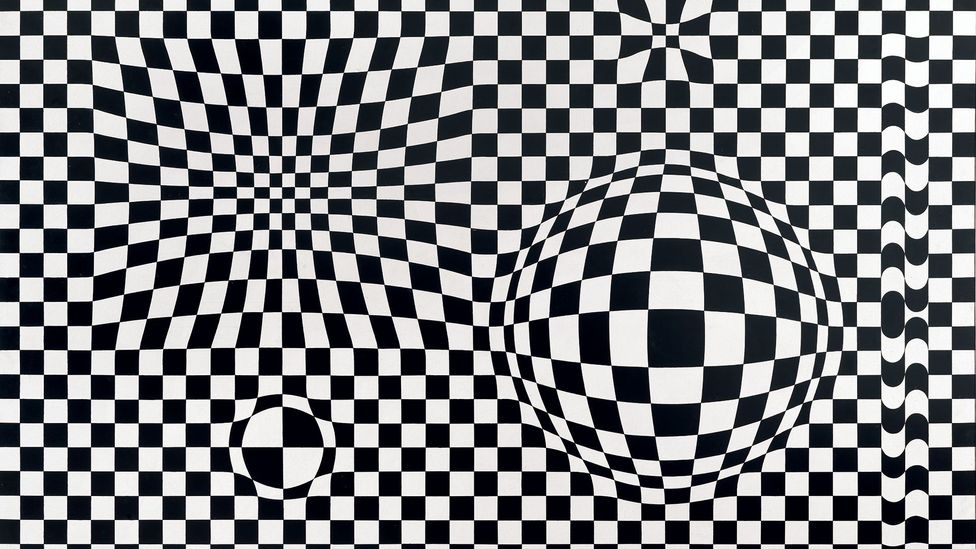
Currently on view at the Pompidou Centre in Paris, Victor Vasarely's mesmerising work was inspired by zebras and camouflage.
B
By the early 1970s, Victor Vasarely was everywhere. Regarded past historians today as the 'grandfather' of Op Fine art, the Hungarian-French abstract artist, then in his late sixties, had watched his pioneering geometric designs and hypnotising optical illusions come to stand for his generation. Vasarely's advisedly calibrated patterns of bright squares and luminous circles, which make his paintings' surfaces announced like warping space-time webs – now rippling and concave, now spinning and convex – was the hottest of hot demands.
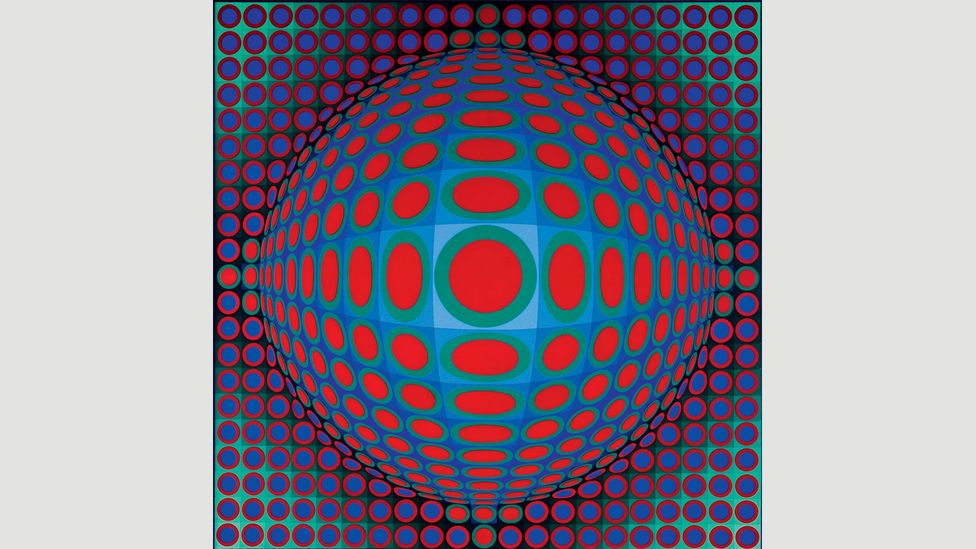
Vega 222, 1969-1970 (Credit: Erling Neby Collection, Oslo/Photo Øystein Thorvaldsen)
Renault, the automobile manufacturer, hired him to redesign the company's famous logo. David Bowie hired him to create the cover art for his album Space Oddity. Most, however, merely plagiarised the poetic physics of Vasarely's elegant grilles and melting lattices, desperate to tap into the futuristic wonder of their sleek style, without paying him a cent or acknowledging their debt.

Renault logo, 1972, by Victor Vasarely and Yvaral (Credit: Fabrice Lepeltier)
More than similar this:
- One of art's most enduring puzzles?
- The puerile joke hidden in a 16th-Century painting
- Unsettling images twisted from Disney
A major exhibition devoted to Vasarely, now on at Centre Pompidou in Paris, has assembled more than 300 paintings, drawings and Popular Art objects that map his long career every bit a tireless innovator of 20th-Century abstract art. Among the dizzying inventory of images collected for the evidence is a formative ink-on-paper work that stands out equally pivotal to the growth of one of the most under-appreciated imaginations in modern cultural history. Created in 1938, when Vasarely was still earning his stripes as a jobbing graphic designer in Paris (having finished art school at the Bauhaus-inspired Muhely Academy in Budapest a decade earlier), the deceptively uncomplicated monochrome piece of work belongs to a series of studies devoted to the muscular move and mesmerising markings of the African equid.

Zèbres-A, 1938 (Credit: Vasarely Foundation/Photograph: Fabrice Lepeltier)
Weaving and unweaving the beast's black-and-white stripes, the transfixing depiction of a pair of wrangling zebras strobes strangely before our optics. The wild, striated sinews of the tussling pair in Zebres-A (1938) announced to drum and quiver, as if alternately kicking outwards towards the observer, beyond the image's surface, and recoiling into the invisible absence of the empty white field from which they've miraculously emerged. The tangle of flexing lines is almost kinetic in the fluid, fluctuating move it magicks from the simplest and sparest of pen-and-ink gestures.
Calculation to the dislocating issue of Vasarely's advisedly controlled anarchy is the sheer surprise of seeing zebras in a work of art in the first place. In the Noah's ark of art history, it's the horse – the zebra'south zoological cousin – that has conventionally commanded our attention, trotted out on the walls of museums and galleries. The horse, of course, runs correct through the long saga of image-making from the Stone Age to the nowadays. From the prehistoric charcoal broncos that gallop across the rough interior of the Lascaux caves to the countless stallions stitched into the Bayeux Tapestry; from the steed in Jacques-Louis David's Napoleon Crossing the Alps to the tortured neigh that whinnies at the centre of Picasso'southward Guernica, horses have reigned supreme in cultural consciousness. (And that's non even mentioning the stampede of George Stubbses out at that place). Zebras? Not then much, despite the fact that they, more than any fauna, seem half-drawn into the existent earth of fully filled-in colour – suspended midway between the Bharat ink of an creative person'due south draughting table and the blinding hues and havering heat of a mirage-soaked savannah.

Kroa MC, 1970 (Credit: Fabrice Lepeltier)
In Vasarely's zebra portraits, the distinctive markings of the animal are transformed from something physical and empirical – pigment and hibernate – to mysterious metaphors for an almost transcendental phenomenon: the merging of the heed of the observer with the impalpable spirit of the natural world. They seem more similar a sophisticated meditation on how the eye stalks the e'er-elusive object of its gaze, rather than an try to chronicle the animate being's magnetic mien.
I can't assist wondering whether the creative person may have been influenced, knowingly or otherwise, past experiments undertaken past maritime designers in the Us and the Great britain admiralties during the outset and 2d world wars, camouflaging their warships with markings inspired by the zebra. Assertive that zebras may take evolved their distinctive stripes every bit a defence force confronting predation (allegedly making it difficult for predators to isolate a single target or to appraise the depth of field in which their casualty moved), the British artist Norman Wilkinson proposed cloaking vessels in a jumble of angular black-and-white striations to confuse adversaries. And so-called 'razzle-dazzle' wasn't intended to return a ship physically imperceptible, simply merely to jam the senses of the approaching enemy.
Stripes and stars
Tracing the growth of Vasarely's imagination as it emerges over the course of the hundreds of works assembled into seven rooms of this vast exhibition, one increasingly appreciates what a game-irresolute revelation the dazzling hide of the zebras clearly was for the artist. Before figurative works of soulless, mannequin-like automatons inhabiting vacated cityscapes seem static by comparing, and bear witness the young artist foraging around in the borrowed language of surrealism and constructivism for something authentic to his ain fashion of seeing.
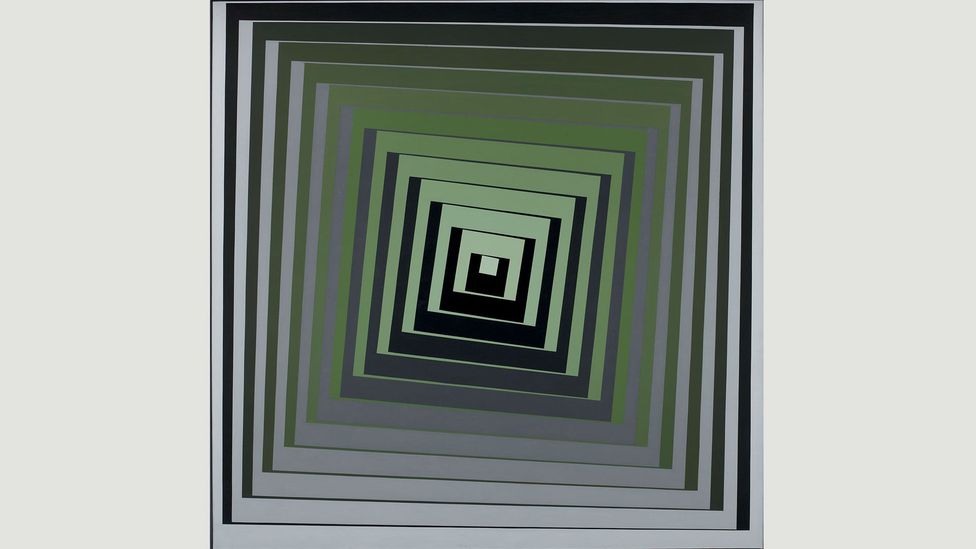
Vonal Zold, 1968 (Credit: Editions du Griffon/Sully Balmassière)
Every work past Vasarely that follows on from the zebra breakthrough seems inflected by that muscular epiphany. During the war years and later, Vasarely found himself ineluctably drawn in the management that his hypnotic zebras were pulling – obsessed with scientific literature and ground-breaking optical theories. He found himself attempting to sync his vision with every undulation observable in the world around him, whether natural or manmade.
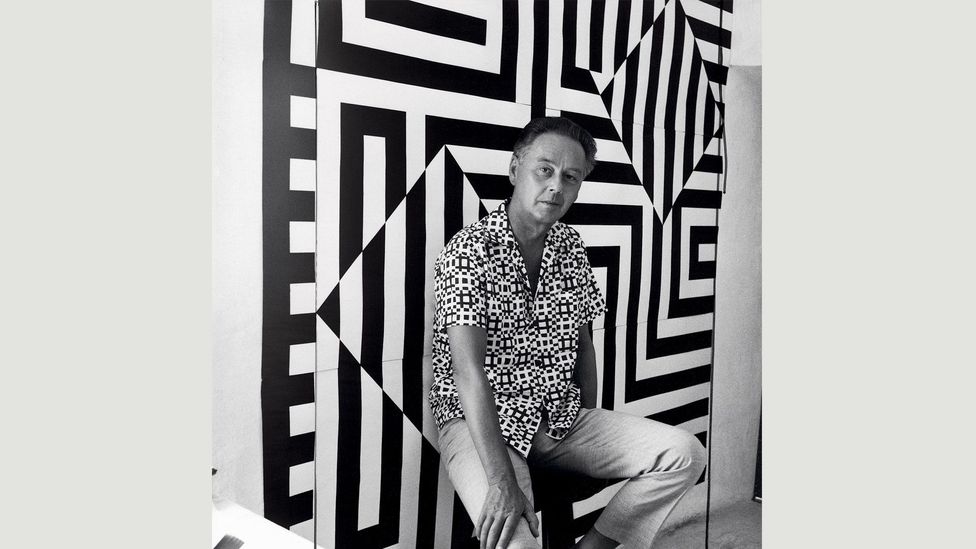
Victor Vasarely in 1960 (Credit: Willy Maywald)
In an endeavor to perceive an invisible compages that underlies reality, he began scrutinising everything from the motion of the tides to the organic pattern of cracks and fissures in subway tiles. The consequence was a series of monochromatic works created throughout the 1940s and '50s that are very much in accordance with the spiritual temperament of his meliorate-known contemporaries such as Arshile Gorky, Piet Mondrian and the Swedish mystic Hilma af Klint, whose secretive work – hidden from public view during these decades – is itself now undergoing a major revival.
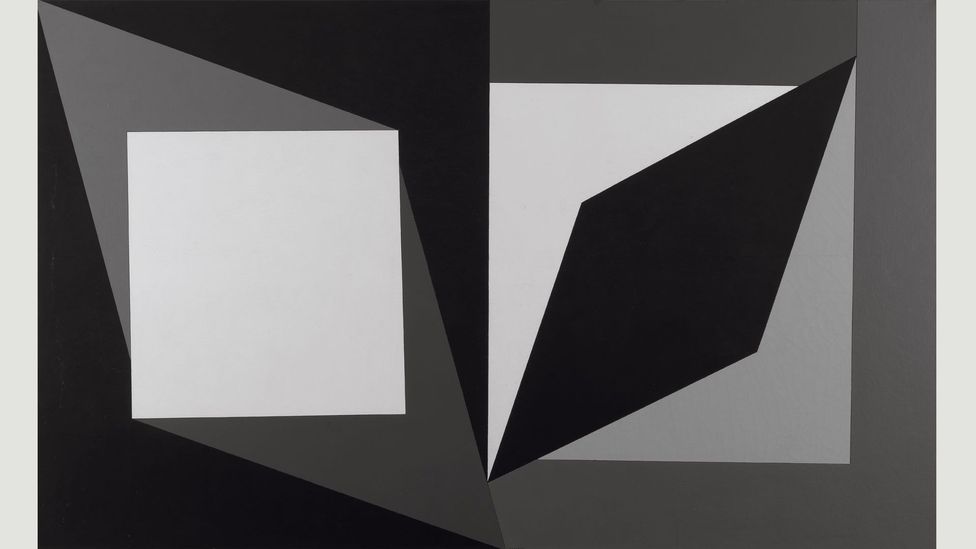
Hommage à Malévitch, 1954-1958 (Credit: Louis Bogaerts Drove/Photo: Philippe Migeat)
In Hommage à Malévitch (1954-58), it is every bit if Vasarely has taken the Russian advanced artist's famous Blackness Square (1915), which Malevich himself believed embodied the 'spirit of non-objective feeling… which penetrates everything', and tied that legendary canvas to the twisting tendons of a zebra'south fierce physique, tugging it out of all proportion. The melting chessboard of Vasarely'southward elastic oil-on-sheet painting Vega (1956), created around the aforementioned time as Hommage à Malévitch, seems likewise committed not and then much to measuring the weight and substance of what we actually perceive in the globe effectually the states, but, paradoxically, to offering a glimpse into the unseeable forces and gravities that twist and distort our perception. Here, information technology feels like the memory of the zebra's stretching and contracting stripes has been fed through a digitising scanner or the pixelating mince of a particle collider in order to decrypt the binary lawmaking of its artful essence.
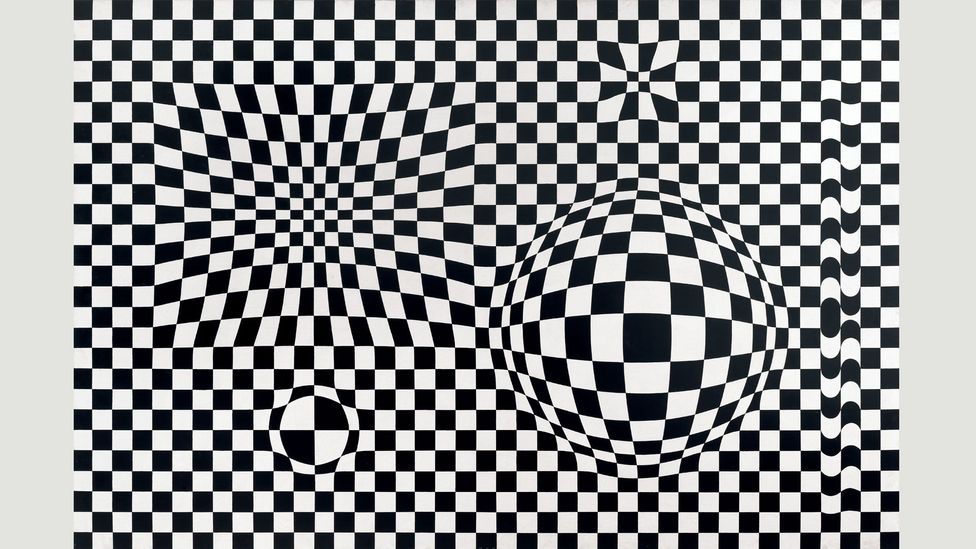
Vega, 1956 (Credit: Belgique Photo/Photograph: Philippe Migeat)
By the 1960s, Vasarely had hit his pace in establishing what he believed were the archetypal gestures of a universal linguistic communication, one that was fully in harmony with the dauntless new scientific discoveries of his age – "worlds which", he would write, "up until now, have escaped the investigation of the senses: the world of biochemistry, waves, fields, relativity". Vibrant color, which he had used relatively sparingly in the years since depicting his kickoff zebra, begin to seep dorsum into the artist's work as a new generation of artists such as Bridget Riley, whose ain engrossing lines strummed in tune with his, helped give his innovative vision corroborating traction.
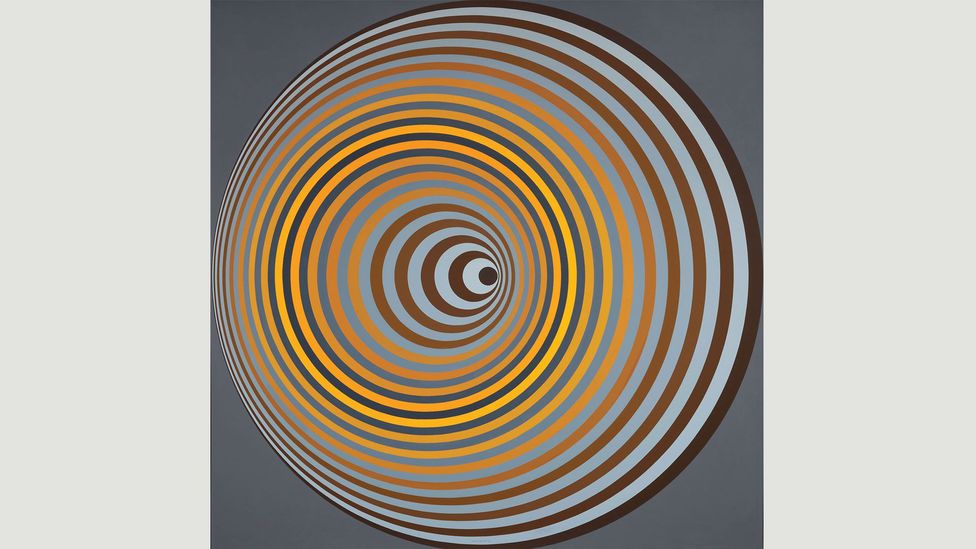
Szem, 1970 (Credit: Editions du Griffon/Sully Balmassière)
However increasingly complex the algorithms that generated works such as Vonal Zold (1968) and Szem (1970) may initially seem, the verve of their pulsing vortices and the rhythm of their thrumming music tin can exist traced back, decades earlier, to the bold prance and trip the light fantastic of zebra stripes that caught the creative person's soul off guard, and trampled it into genius.
Victor Vasarely is at the Pompidou Centre in Paris until May 2019.
If you lot would like to comment on this story or anything else you have seen on BBC Culture, head over to our Facebook page or message u.s.a. onTwitter .
And if you lot liked this story, sign up for the weekly bbc.com features newsletter , chosen "If You But Read 6 Things This Week". A handpicked selection of stories from BBC Time to come, Civilisation, Capital and Travel, delivered to your inbox every Friday.
Source: https://www.bbc.com/culture/article/20190305-victor-vasarely-the-art-that-tricks-the-eyes#:~:text=By%20the%20early%201970s%2C%20Victor,come%20to%20represent%20his%20generation.
0 Response to "What Kind of Art Was Victor Vasarely Called Grandfather of"
Publicar un comentario